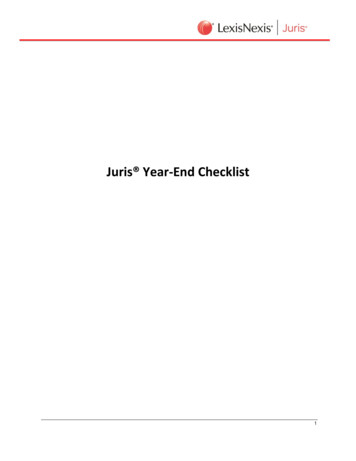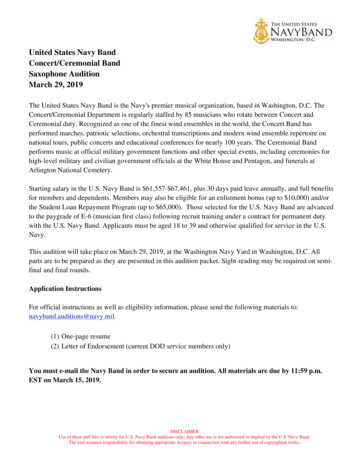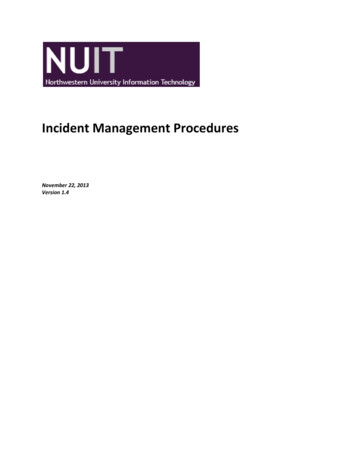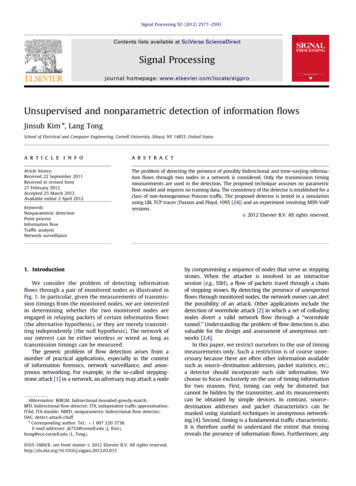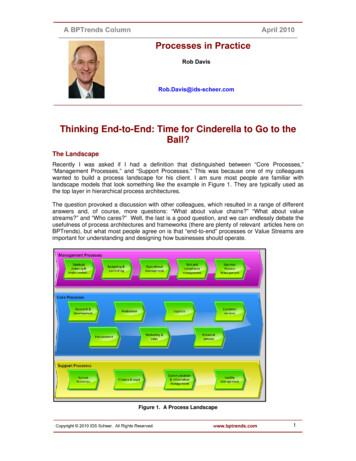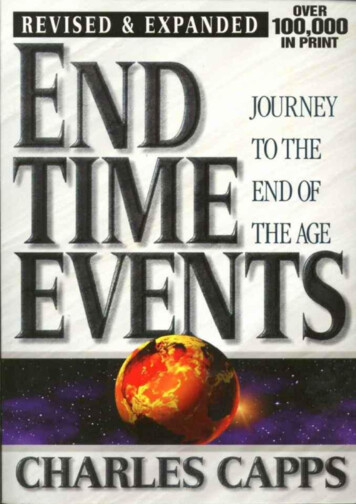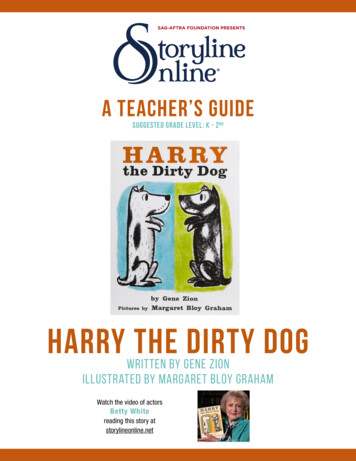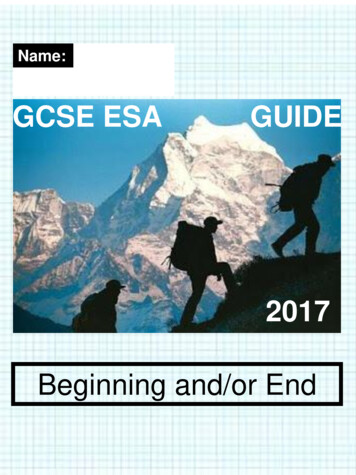
Transcription
Name:GCSE ESAGUIDE2017Beginning and/or End1
Page one: Title page1. Prepare the background – eg Stick in a torn/collaged/tea stained page2. Cut up brainstormed words linked to theme (word processed if your handwriting is notclear) and stick inDone!Page two and three: Visual brainstorm1. Select images from Pinterest or the internet (search ‘atmosphere photography’ tofind lots of gorgeous photography that will fit with any theme)2. Copy, paste and print out images that link to the theme AND the previous title pageand drawings3. Arrange attractivelyDone!2
Suggested themes or areas of research1. PeoplePeople can experience different emotions when beginning and ending relationships. This could perhaps present youwith a way of investigating the theme. Most people follow the same routine at the beginning and end of every day.You might start the day with breakfast, then wash, dress and check your mobile. Andrew Curtis’s photograph,Sarah, 2008, shows a young girl texting on her mobile. Daily routines have inspired a number of artists, designersand craftworkers. Could you use similar starting points for your response?Immigrants, refugees and the homeless often face the challenges of beginning a new life in another place orcountry. They frequently leave family and friends behind and feel isolated and lonely; these are issues a number ofartists have investigated. Could you use similar ideas to develop your work?Beginning a new phase in your life is often celebrated, for example, a wedding, birthday or retirement. Could anoccasion when people celebrate a new phase in life offer you a way of exploring the theme? The end of childhoodand the start of adult life bring many psychological and physiological changes. Sir John Everett Millais’s paintingAutumn Leaves has typically been interpreted as a representation of the transience of youth and physical beauty.Could this, or a similar source, provide you with inspiration for your response?2.PlacesAirports, stations and ports are all places where we begin and end journeys. Could such a place be the inspirationfor your response? Our homes are where most of us begin and end the day, and are full of personal and interestingbelongings. Observing and recording your home or the things in it might present you with a way of investigating thetheme. Towns, cities and the countryside, can look very different early in the morning and late at night. Thebeginning and end of the day in such places can be a source of inspiration for artists, designers and craftworkers.Could you use similar starting points for your response? M.C. Escher’s lithograph Ascending and Descending shows atype of optical illusion. The image depicts a large building roofed by a never-ending staircase with no beginning orend. Could investigating similar sources provide you with an interesting starting point?A sports stadium, school canteen or an outside space can look very different at the beginning of an event from howit looks at the end. For example, these places can look very untidy after a music festival or celebration. Could youuse the appearance of a place as a starting point for your response?Assembly lines in factories are where the production of cars, household appliances and electronic goods begin andend. Could investigating such a process provide you with a starting point for your work? Important and impressivebuildings are designed to be a symbol of power, independence and reform. Enric Miralles’s Scottish ParliamentBuilding could be seen as a symbol of a new beginning for a country wanting change and independence. Could youinvestigate similar sources and ideas to inspire your response?3.Natural WorldThe beginning and end of life are expressed by artists, designers and craftworkers in many ways. Could birth anddeath observed in the natural world be a source of inspiration for your response? Amazing displays of colour andlight seen at dawn and dusk can provide artists, designers and craftworkers with a source of inspiration. Observingand recording such scenes might provide you with an interesting starting point.Discovering and blending natural materials can offer artists, designers and craftworkers new and innovativeapproaches to making and constructing artefacts. Andy Goldsworthy’s sculpture Incredible Serpentine Tree Roots isa seamless blend of found materials, it is difficult to detect where the sand ends and the living tree begins. Couldsimilar processes offer you an interesting way to explore and research the theme? The seasons begin and end,bringing about events such as new shoots in spring, summer’s heat and light, the changing colours of autumn andthe first frost of winter. These changes create amazing scenes of colour and drama, which might provide you withan interesting starting point for your work.The flow of water at the end of a melting glacier is where a river can begin its journey, ending when the river joinsthe sea. Could a similar journey provide you with ideas? All living things have a life cycle. After a sensational displayof colour and form, flowers lose their petals and seed heads begin to form. In the photograph Single Oriental Poppyby Irving Penn the last two petals are about to drop. Could you investigate life cycle changes in the natural world toinspire your outcome?3
4.ObjectsRecycling, reusing, restoring or repairing objects means they could begin to be used or appreciated again. Couldresearching and investigating similar processes help you develop your response?Objects can be used to symbolise life stories from the beginning to the end. Pharmacopoeia’s contemporary artinstallation Cradle to Grave uses a lifetime’s supply of prescribed drugs sewn into two lengths of textile to symbolisea person’s life. Could researching similar contextual sources and exploring unusual ways of working provide youwith inspiration?Using and finishing the contents of a flexible container might change its shape, size and appearance. For example, atube of paste, sachet of sauce and sweet wrappers all change when their contents are used. Could investigating theappearance of flexible packaging provide you with a way to develop your response?Objects arranged on a table to begin a meal or table game can look very different once the activity has ended. Couldobserving and recording contrasting arrangements of objects provide you with an interesting way to begin? Artists,designers and craftworkers can push the boundaries when they begin to create original ideas, where functionalityends and decoration takes over. Adornment and embellishment can sometimes be overwhelming. NicholasKirkwood’s highly decorated shoes Alice in Wonderland Heels are an example of fantastic shoes with an emphasison beautification. Could experimenting with function and decoration offer you an interesting starting point?5.ActivitiesThe beginning of a New Year is celebrated in many different ways in countries around the world. Could the activityof celebrating the New Year inspire ideas for your work?The anticipation and excitement at the start of a race and the exhilaration or disappointment at the end can be asource of inspiration for artists, designers and craftworkers. Sir Alfred Munnings’s painting Moving Up For the Start:Under Starters Orders captures the moment before the start of a horse race. Could the activities at the beginningand end of a race provide you with an interesting starting point? Religions throughout the world have ceremoniesto mark birth and death. Could a ceremony marking birth or death provide you with ideas for your response? Thescene before and after conflict can provide artists, designers and craftworkers with a source of inspiration for theirwork. For example, could the calm before a storm or the chaos after war provide you with an interesting startingpoint?Celebrating the completion of an activity creates an atmosphere of jubilation. Observing and capturing the momentmight provide you with a way to develop your response. Maps enable us to work out how to travel and plan whereto begin and end a journey. Artists, designers and craftworkers sometimes use bright colours and bold text to helpmake maps clearer to understand. Harry Beck’s London Underground Map is used daily by people travelling aroundthe city. Could a similar contextual source provide you with a starting point for your work?6. ImaginationGoing through an entrance or exit can bring a new viewpoint, outlook or horizon. What you observe through anentrance or exit might provide you with a starting point for your response. A collision with a barrier can endmovement or access. In Alyssa Monks’s painting Scream a face is pressed against a shower door with an expressionthat suggests a desire to escape. Could you use the idea of being entrapped to inspire your response?War, famine, disease or extreme weather can end the normal functioning of a community. Rebuilding a communityhas to happen before normality can begin again. Could exploring the visual impact of a serious disaster help youdevelop ideas for your work?We might be entering a new phase in human history where fewer and fewer humans are needed to produce goodsand provide services. Artists, designers and craftworkers sometimes face the challenge of creating devices that dothe work humans have done in the past. Could a challenge like this provide you with a starting point?There are many theories about how the universe began. You can only imagine what the beginning of the universelooked like. Could you use this idea as a starting point for your response?Sometimes artists, designers and craftworkers try to imagine what the end of the world could look like. Dennis Lee’sposter It’s the End of the World Now Run Screaming advertises short plays about the apocalypse. You might be ableto imagine what happens if an asteroid, nuclear holocaust or total environmental breakdown descends on us. Couldyou use these ideas for your work?4
Pages four and five : Related observational studies1. Prepare the pages – tea stain, collage, paint with watercolour etc2. Select a photograph or object that links to the suggested themes3. Focus on an area that is no less than 8cm x 8cm, no bigger than 12cm x 12cm4. Carefully and slowly draw, monoprint or paint your photograph so it looks like the original5. Complete three – four studies using a range of mediaDone!Pages six and seven: Artist/Photographer or Designer 11. Your double page must have been ‘treated’ already so it links to the artist!2. Select an artist whose style and ideas link with what you’ve done so far in thissketchbook3. Print and present four small but clear images of the artist’s work4. Type up an analysis and stick beside the images5. Only stick in a contact sheet of a few photos that you have used directly in this response6. Stick in a completed replication/transcription or response7. Annotate reflecting on how successful your response/transcription was and where youmight go with this work nextDone!ARTIST name5
Example 1:6
Example 2:7
Page eight and nine: Artist 21. Your double page must have been ‘treated’ already!2. Select a designer whose style and ideas link with what you’ve done so far in this sketchbook3. Print and present four images of the designer’s work4. Type up an analysis and stick beside the images5. Stick in a completed replication/response6. Annotate reflecting on how successful this wasDone!Artist NamePages ten and eleven: Artist 31. Your double page must have been ‘treated’ already!2. Select a designer whose style and ideas link with what you’ve done so far in this sketchbook3. Print and present four images of the designer’s work4. Type up an analysis and stick beside the images5. Stick in a completed replication/response6. Annotate reflecting on how successful this wasDone!Artist Name8
Summary pageSentence builderThe artists/designers I looked at had themes of . in their work. I looked at them because Ifelt they linked closely to the externally set assignmenttheme of I liked the work of (insert designer’s name here). and (insert designer’s name here) . in particular and foundtheir work (insert your opinion of their work here).The replication/response featuring (insert materials andtechniques here) and (insert the type ofimage you used here) . worked wellbecause (reflect on how you can tell it was successful)In order to develop the work, I (explain the process briefly) Iparticularly enjoyed . and . .The two areas I will focus on will be . and .because . .I’d like to experiment further with . .I will take photos of . to continue developingideas.Make sure that you have taken clear, close-up photos ofall the replications, responses or photography that youmay have taken and stuck them in neatly and in asensible order, along with the written explanation9
Page twelve and thirteen: Summary page1. Your page must have been ‘treated’ already!2. Photograph your replications/responses3. Print out these photos and stick in4. Type up your summary use the sentence builder in this booklet to get startedDone!Summary pagePages fourteen and fifteen: Area of focus1. Your double page must have been ‘treated’ already!2. Take a broad range of photographs that link with the two areas you have identified.3. Print a contact sheet and circle the ones you will move forward with, annotating withexplanation of why you’ve taken the photos.4. Print out those selected and stick inArea of Focus10
Page sixteen and seventeen: Exploration: area of focus1. Your page must have been ‘treated’ already!2. Select a photo, stick it in , then use it!3. Complete drawings and test pieces using a range of media and Techniques (Skilfully) thatlink to your artists4. Annotate, reflecting critically on the success of each sample and what you might attemptnextExploration: Area of focus (floralDone!anatomy)Pages eighteen and nineteen: Exploration1. Your page must have been ‘treated’ already!2. Select a new photo, stick it in , then use it!3. Complete drawings and test pieces using a range of media and Techniques (Skilfully)that link to your artists4. Annotate, reflecting critically on the success of each sample and what you might attemptnextDone!Exploration:Area of FocusArea of focus (floralanatomy)11
Page twenty and twenty-one: Exploration: Second areaof focusYour page must have been ‘treated’ already!1. You must make it really clear what you are exploring that is different from yourfirst area of focus2. Select a photo from your second area of focus, stick it in , then use it!3. Complete samples/drawings using a range of media and Techniques (Skilfully)4. Annotate, reflecting critically on the success of each sample and what you mightattempt nextDone!Exploration: Area of focus (humananatomy)12
Page twenty-two and twenty-three: Final idea development1. Your page must have been ‘treated’ already!2. You must complete two pages of thumbnail sketches that marries your twoareas together3. They must show a range of ideas exploring differing compositions, materials andtechniques4. This might involve small sketches or trial piecesFinal idea development13
Example 3:example 4:14
Page twenty-four and twenty-five: Final idea development1. Your page must have been ‘treated’ already!2. You must now complete trial pieces derived directly from thumbnail sketches, exploringthe best use of materials and techniques in each potential composition3. Annotate- reflect critically on how well each trial has worked and which will be the best touse for a final outcome – explain why?Final ideadevelopmentPage twenty-six and twenty-seven: Final idea development1. Your page must have been ‘treated’ already!2. You must now make progress- trial pieces should become more and more complex andshould build on the previous one, containing a number of different features in each one.3. You should continue to identify the best use of materials and techniques4. Annotate- reflect critically on how successful it was and how successful it might be in the finaloutcomeFinal ideadevelopment15
Page twenty-eight and twenty-nine: Final idea development1. Your page must have been ‘treated’ already!2. You must now make progress- tests should become more and more complex andshould build on the previous one, containing a number of different features in each trialpieces3. If you want to bring in a new element, complete a research page with an explanationof how you are interpreting the new artist’s work and what you will use in your ownwork e.g an idea or a new media4. Annotate- reflect critically on how successful it could be in the final outcomeFinal idea developmentDesigners exploring’ memories’ as a themePage thirty and thirty-one: Final idea development1. Your page must have been ‘treated’ already!2. You must complete drawn final designs for each of the outcomes you will make.They must be clear and skilful and make use of your most successful/relevant samples3. They must be explained fully- identifying what they mean/communicate and theartists/designers that inspired your final outcomes16
Page thirty-two and thirty-three: Final design and TRIALPIECE1. Your page must have been ‘treated’ already!2. You must complete final test prototypes for your final outcomes3. Reflect critically on their success, explaining any tweaks you might make to the finaloutcomes based on what you learned from the trial pieceFinal idea development17
Page thirty-four and thirty-five:Evaluation and Photo of Final Piece18
find lots of gorgeous photography that will fit with any theme) 2. Copy, paste and print out images that link to the theme AND the previous title page . Sir John Everett Millais’s painting . Towns, cities and the countryside, can look very different early in the morning and late at night
